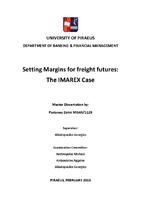Setting margins for freight futures: the IMAREX case

Προβολή/
Θεματική επικεφαλίδα
Freight market ; Freight and freightage ; Value at Risk ; Ναυτιλιακή οικονομικήΠερίληψη
The main characteristics of the shipping business are its highly volatile freight rates, seasonality, strong business cycles and capital intensiveness. Being such a high-risk business, it is evident that risk management and analysis of the market conditions are of outmost importance. Modern financial instruments like Forward Freight Agreements (FFAs), freight futures and freight options can be very useful to manage some of the risk in shipping (Rasmussen and Tversland, 2007). Freight derivatives are financial instruments for trading in future levels of freight rates, for dry bulk carriers, tankers and containerships. These instruments are settled against various freight rate indices published by the Baltic Exchange (for Dry and most Wet contracts) & Platt's (Asian Wet contracts). Market participants that actively manage risk with such tools will then be less exposed to market volatility than they would otherwise be. More specifically, they can use them as a hedging tool, which means a tool with which they can minimize the portfolio price variance.


